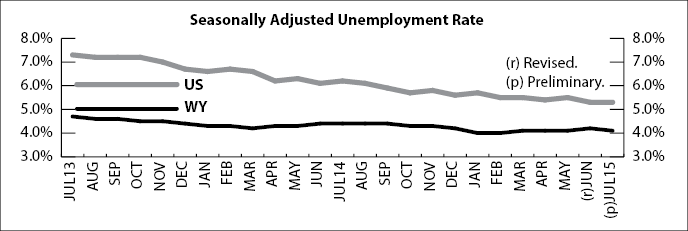
Wyoming Unemployment Rate at 4.1% in July 2015
The Research & Planning section of the Wyoming
Department of Workforce Services has reported that the state's seasonally
adjusted1 unemployment rate fell very slightly from 4.2% in June (as revised) to 4.1% in July. Wyoming’s unemployment rate has remained within the narrow range of 4.0% to 4.2% in each of the past eight months. Seasonally adjusted employment of Wyoming residents increased slightly, rising by an estimated 844 individuals (0.3%) from June to July. This level of over-the-month employment growth is a normal change.
From June to July, most county unemployment rates followed their normal seasonal pattern and decreased. Typically, employment rises in many sectors in July, including leisure & hospitality, construction, and professional & business services. The largest unemployment rate decreases were seen in Uinta (down from 4.8% to 4.2%), Teton (down from 2.7% to 2.1%), Goshen (down from 3.5% to 3.0%), Crook (down from 3.2% to 2.7%), and Converse (down from 3.6% to 3.1%) counties. Niobrara County’s unemployment rate rose modestly from 2.8% to 3.1%.
From July 2014 to July 2015, unemployment rates fell in 17 counties, rose in five counties and remained unchanged in Converse County. The largest decreases occurred in Crook (down from 3.7% to 2.7%), Platte (down from 4.3% to 3.4%), Teton (down from 2.9% to 2.1%), Lincoln (down from 4.5% to 3.7%), Albany (down from 3.8% to 3.0%), and Goshen (down from 3.8% to 3.0%) counties. Unemployment rates increased in Natrona (up from 3.9% to 4.4%), Campbell (up from 3.3% to 3.5%), Fremont (up from 5.0% to 5.2%), and Sweetwater (up from 4.1% to 4.3%) counties.
The highest unemployment rates were found in Fremont (5.2%), Natrona (4.4%), Sweetwater (4.3%), and Uinta (4.2%) counties. Teton County had the lowest unemployment rate (2.1%). It was followed by Crook (2.7%), Weston (2.8%), Goshen (3.0%), and Albany (3.0%) counties.
Total nonfarm employment (measured by place of work) rose from 301,400 in July 2014 to 302,600 in July 2015, a gain of 1,200 jobs (0.4%; not a statistically significant change).
1Seasonal adjustment is a statistical procedure to remove the impact of normal regularly recurring events (such as weather, major holidays, and the opening and closing of schools) from economic time series to better understand changes in economic conditions from month to month.
